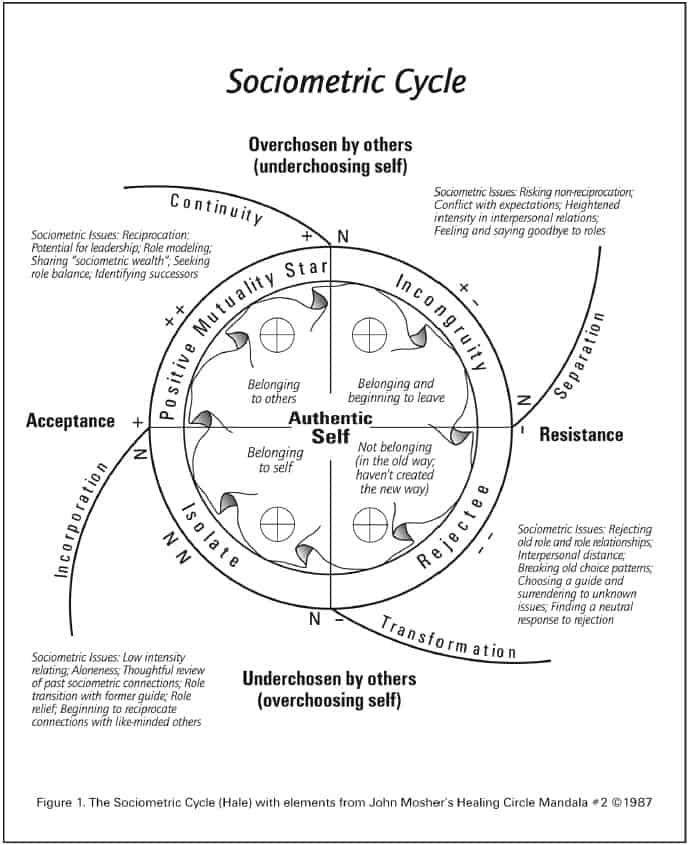Ann Hale’s sociometric cycle is a four-stage process that tracts the sociometric status and development of an individual. Each stage corresponds to a season (spring, summer, fall, and winter), and each season metaphorically represents the different phases of the sociometric analysis.
The sociometric cycle is a map which may be used to assist a group in exploring the natural progression of each member into and out of roles, and to the related positions they have in a group originating from choices they make for one another. The cycle makes it possible to direct attention to the ways these progressions may be facilitated or impeded.
Hale, Three Cyclical Models Which Enhance Consciousness of Interpersonal Connection, 2012
The Development of the Sociometric Cycle
Hale was one of the preeminent contributors to Moreno’s theories of social connection, broadly called “sociometry.” Moreno offered procedures such as the social atom, the sociometric test, and the role diagram, etc., which may be further explored using action methodologies he developed: psychodrama, sociodrama, role play and others (Moreno,1934, 1950, 1978).
Hale contributed much to Moreno’s theories, and wrote and taught extensively on the topic of sociometry. As it relates to her development of the sociometric cycle, Hale’s great contribution to the field, she offers the following:
In 1986 psychodramatist and psychotherapist John Mosher introduced his colleagues to The Healing Circle: Myth, Ritual and Therapy at a psychodrama conference in Santa Monica, CA. I was fascinated with his cyclical mapping of all kinds of group phenomena. The circle was divided into four quadrants with two intersecting polar opposites. I had recently read about the medicine wheel in Joseph Campbell’s The Hero with a Thousand Faces, featuring a quartered circle outlining a journey. I had begun to think of relationships and group experiences as “journeys” or “quests.” Enormously impressed with Mosher’s work, I spent the evening following his workshop at a festive event, seated in the corner of a couch, scribbling away making my sociometrist’s connections. Within a few hours I had the basic template for the sociometric cycle.
Hale, Three Cyclical Models Which Enhance Consciousness of Interpersonal Connection, 2012
The Four Quadrants
The four quadrants of the divided circle are identified with the four primary sociometric positions:
- Positive star (+/+) is a person who receives a high number of positive choices which
they also reciprocate; - Star of incongruity (+/-) is a person who has a high number of connections with positive
choices returned by negative or neutral choices, or negative choices returned by positive
or neutral ones; - Rejectee (-/-) is a person who receives a high number of rejections on the criterion which
he or she reciprocates; - Isolate (N/N) is a person receiving a high number of neutral choices on the criterion who
also responds with neutral responses.
When teaching the sociometric cycle, Hall indicates:
When describing the sociometric cycle for the first time to someone I usually begin with acceptance of (1) being highly chosen by others (+/+) then move toward (2) resistance to being overchosen (+/-); and then I cycle toward (3) resistance to being underchosen by others (-/-) and then on to being receptive to greater and greater degrees of acceptance of (4) being underchosen (N/N).
Hale, Three Cyclical Models Which Enhance Consciousness of Interpersonal Connection, 2012
Exploring the Sociometric Cycle

Let’s explore what now happens to an individual’s sociometric status during each season of the sociometric cycle:
Spring (Plus Plus – Sociometric Wealth)
In the spring season of the sociometric cycle, individuals experience a sense of belonging and sociometric wealth. This is characterized by “plus plus” connections, meaning that the individual’s sociometric choices are reciprocated by others, and they have a multitude of positive social connections available to them.
During spring, the individual feels a strong sense of inclusion and social support, as their positive interactions are met with positive responses from others. They may enjoy being part of various social circles, having many friends, and feeling appreciated by their peers. This sociometric wealth can be uplifting and fulfilling, providing a sense of belonging and acceptance.
However, the abundance of sociometric choices can also pose challenges. Each social connection requires time and effort to maintain, and the individual may feel overwhelmed or burdened by the reciprocal responsibilities. This could potentially lead to burnout if they struggle to manage their relationships effectively.
Summer (Plus Minus – Sociometric Struggles)
As the sociometric cycle transitions into summer, individuals may experience sociometric struggles characterized as “plus minus” connections. This means that while the individual has positive sociometric choices (plus), not all of their interactions are reciprocated positively (minus).
During summer, the individual may encounter social challenges, such as conflicts or strained relationships, resulting in occasional negative responses. This can lead to feelings of ambiguity and insecurity within the social network. The individual may need to navigate complexities, address conflicts, and work towards restoring balance in their social interactions.
Fall (Minus Minus – Sociometric Isolation):
In the fall season of the sociometric cycle, individuals may face sociometric isolation, represented as “minus minus” connections. This indicates that the individual’s sociometric choices are not reciprocated positively, and they may experience a lack of social support and connection.
During fall, the individual may feel excluded or marginalized within the social network. They might struggle to find meaningful social connections or experience rejection from their peers. Sociometric isolation can lead to feelings of loneliness and low self-esteem, impacting their overall well-being.
This is the “season” or phase in the sociometric cycle where an individual experiences the greatest level of conflict. Think of a marriage that is in the midst of a divorce as an example.
Winter (Neutral/Neutral) – Sociometric Transformation)
In the winter season, the sociometric cycle reaches its final stage, marked by sociometric transformation represented as “Neutral Neutral” connections. This means that the individual’s sociometric choices are reciprocated positively, but they may have limited sociometric choices available to them.
During winter, the individual may experience a shift in their social network, developing stronger and more meaningful connections with a smaller circle of supportive peers. While they may have fewer sociometric choices, the positive reciprocation brings a sense of stability and authenticity to their social interactions.
Conclusion:
Ann Hale’s sociometric cycle provides a valuable framework for understanding the dynamics of social relationships over time. From the abundance of sociometric wealth in spring to the sociometric challenges and transformations in summer and winter, individuals move through a variety of sociometric statuses that, when properly navigated, lead to personal growth and understanding.

